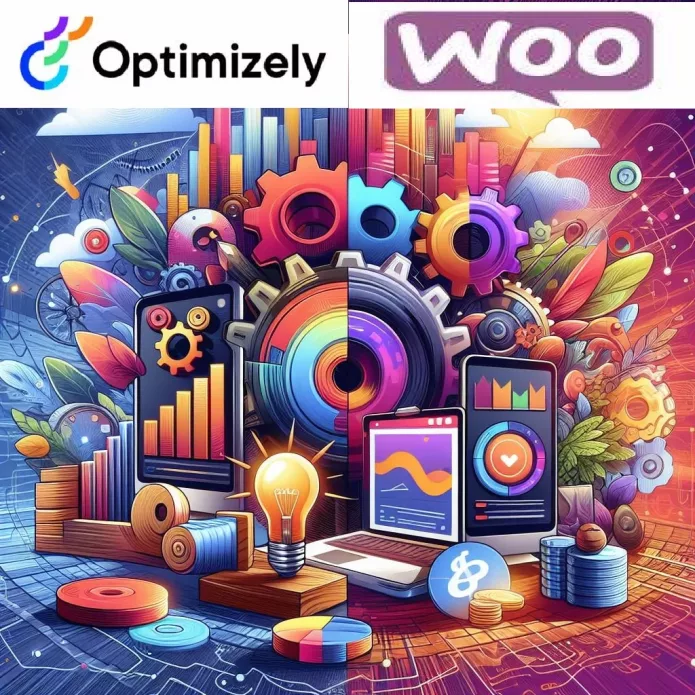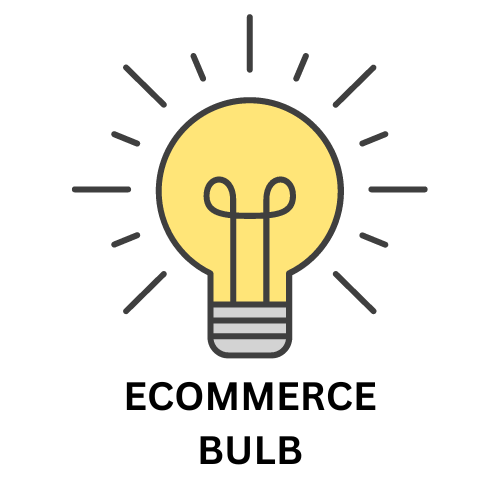In order to decide which ecommerce platform to use, WooCommerce vs Optimizely. A detailed comparison between features must be thoroughly done. If you want to decide which eCommerce platform to choose, there are many things to consider.
These are some examples of these factors:
- Cost.
- SEO friendliness.
- Page load speed.
- Canonical website URL.
- Indexing Control.
- Customizable HTML capabilities.
- Sitemap Generator.
- Integration with Google Analytics.
- Product Tagging and Categorization.
- Batch Uploading.
- Mobile Optimization.
- Built-in Blogging and Marketing Features.
- Social Sharing Buttons.
- Content Management Capabilities.
- Discount and promotion code tools.
- Easy to use Checkout.
- Reporting tools and custom reports.
- Integration of email marketing tools.
- Multiple payment options.
- Flexibility to add new eCommerce features.
- Exclusive features.
- Cons and pros.
Here we’ll discuss these factors to help you decide which platform is better for you, Optimizely or WooCommerce. And at the end of the discussion, we’ll recap and make a comparison for the scores of all these points to find out which eCommerce platform has the higher score, so that you’ll have a good view about both of them.
Pricing (WooCommerce Vs Optimizely):

Here is a summary and comparison table of WooCommerce and Optimizely pricing tiers:
| Feature | WooCommerce | Optimizely |
|---|---|---|
| Pricing model | Open source with paid extensions | Freemium with paid plans |
| Pricing tiers | 4 | 4 |
| Starting price | $0 | $179/month |
| Features included in starting tier | Basic store setup, product management, payment processing | A/B testing, personalization, content experimentation |
| Target audience | Small to medium-sized businesses | Enterprise-level businesses |
WooCommerce is a free, open-source eCommerce platform that is popular among small to medium-sized businesses. It is a self-hosted platform, which means that you will need to install and manage it on your own server. WooCommerce is a powerful and flexible platform, but it can be time-consuming to set up and configure.
Optimizely is a paid eCommerce platform that is popular among enterprise-level businesses. It is a cloud-based platform, which means that you do not need to install or manage it on your own server. Optimizely is a powerful and scalable platform that is designed for high-volume eCommerce businesses.
Optimizely offers a freemium plan with limited features and usage restrictions. Paid plans start at $179 per month and include features such as A/B testing, personalization, and content experimentation.
SEO Capabilities (WooCommerce vs Optimizely):

Here’s a summary and comparison table of WooCommerce and Optimizely’s SEO capabilities:
| Feature | WooCommerce | Optimizely |
|---|---|---|
| On-page SEO | Basic on-page SEO features, such as meta descriptions and title tags | Advanced on-page SEO features, such as schema markup and structured data |
| Technical SEO | Requires manual configuration of technical SEO settings | Optimizes technical SEO settings automatically |
| Content optimization | Provides tools for creating SEO-friendly content | Provides advanced tools for content optimization, such as content scoring and topic suggestions |
| SEO reporting | Basic SEO reporting | Advanced SEO reporting, including keyword rankings and traffic analysis |
WooCommerce
WooCommerce provides basic on-page SEO features, such as meta descriptions and title tags. However, it requires manual configuration of technical SEO settings, such as sitemaps and robots.txt files. WooCommerce also provides limited tools for content optimization and SEO reporting.
Optimizely
Optimizely provides advanced on-page SEO features, such as schema markup and structured data. It also optimizes technical SEO settings automatically and provides advanced tools for content optimization, such as content scoring and topic suggestions. Optimizely also provides advanced SEO reporting, including keyword rankings and traffic analysis.
Overall, Optimizely has stronger SEO capabilities than WooCommerce. However, WooCommerce is a good option for businesses that are looking for a free and easy-to-use eCommerce platform with basic SEO features.
Here is a table that summarizes the key differences between WooCommerce and Optimizely SEO capabilities:
| Feature | WooCommerce | Optimizely |
|---|---|---|
| On-page SEO | Basic | Advanced |
| Technical SEO | Manual configuration | Automatic optimization |
| Content optimization | Limited tools | Advanced tools |
| SEO reporting | Basic | Advanced |
PageLoad Speed (WooCommerce Vs Optimizely):

Here’s a summary and comparison table of WooCommerce and Optimizely’s page load speed capabilities:
| Feature | WooCommerce | Optimizely |
|---|---|---|
| Page Load Speed | Moderate page load speed | Fast page load speed |
| Factors Affecting Page Load Speed | Theme optimization, plugin usage, hosting quality | Content delivery network (CDN), image optimization, code optimization |
| Tools for Improving Page Load Speed | Manual optimization using plugins or code changes | Built-in performance optimization tools |
| Page Load Speed Impact on SEO | Moderate impact on SEO | Significant impact on SEO |
WooCommerce
WooCommerce can achieve moderate page load speeds with optimization efforts, such as using a lightweight theme, minimizing plugin usage, and choosing a high-quality hosting provider. However, the page load speed can still be affected by factors like product images, product variations, and third-party scripts.
Optimizely
Optimizely is known for its fast page load speeds, thanks to its built-in performance optimization tools. It utilizes a content delivery network (CDN) to deliver content from servers closer to users, optimizes images for faster loading, and minifies code to reduce file size.
Overall, Optimizely has a significant advantage in terms of page load speed compared to WooCommerce. This is due to its built-in performance optimization tools and its focus on delivering a fast and responsive user experience. However, WooCommerce can still achieve decent page load speeds with proper optimization efforts.
Here is a table that summarizes the key differences between WooCommerce and Optimizely’s page load speed capabilities:
| Feature | WooCommerce | Optimizely |
|---|---|---|
| Page Load Speed | Moderate with optimization | Fast out of the box |
| Factors Affecting Page Load Speed | Theme, plugins, hosting | CDN, image optimization, code optimization |
| Tools for Improving Page Load Speed | Manual optimization | Built-in optimization tools |
| Page Load Speed Impact on SEO | Moderate impact | Significant impact |
Canonical Website URL (WooCommerce Vs Optimizely):

Optimizely vs WooCommerce vs WordPress – Canonical Website URL (WooCommerce Vs Optimizley)
Both WooCommerce and Optimizely allow you to set canonical URLs for your pages. This helps search engines understand which version of a page is the original or “master” copy, and which ones are duplicates. This is important for SEO, as it helps ensure that your website is not penalized for duplicate content.
WooCommerce
To set a canonical URL in WooCommerce, you can use a plugin like Yoast SEO. Yoast SEO will add a meta tag to your page’s header that specifies the canonical URL. You can also set the canonical URL manually by adding the following code to your page’s header:
HTML
<link rel="canonical" href="https://your-website.com/original-page-url" />
Optimizely
To set a canonical URL in Optimizely, you can use the platform’s built-in SEO tools. In the Page Editor, go to the “SEO” tab and select the “Canonical URL” field. Enter the URL of the original page and click “Save.”
Here is a table that summarizes how to set canonical URLs in WooCommerce and Optimizely:
| Platform | Method |
|---|---|
| WooCommerce | Yoast SEO plugin or manual meta tag |
| Optimizely | Built-in SEO tools |
Indexing Control (WooCommerce Vs Optimizely):

Both WooCommerce and Optimizely provide options for controlling how your website is indexed by search engines. This is important for SEO, as it allows you to prevent certain pages from being indexed, which can be useful for pages that are not ready for publication or that you do not want to be included in search results.
WooCommerce
WooCommerce does not have built-in indexing control features. However, you can use plugins like Yoast SEO or Rank Math to control indexing. These plugins allow you to set individual pages to “noindex,” which means that they will not be indexed by search engines. You can also use these plugins to set robots.txt rules to prevent search engines from crawling certain directories or files.
Optimizely
Optimizely has built-in indexing control features. In the Page Editor, go to the “SEO” tab and select the “Indexing” field. You can choose to index the page, noindex the page, or use the “Noindex, Follow” directive, which allows search engines to follow links on the page but not index the page itself. You can also use Optimizely’s robots.txt editor to control how search engines crawl your website.
Here is a table that summarizes how to control indexing in WooCommerce and Optimizely:
| Platform | Method |
|---|---|
| WooCommerce | Yoast SEO or Rank Math plugin |
| Optimizely | Built-in SEO tools |
Customizable HTML Capabilities (WooCommerce Vs Optimizely):

Optimizely vs WooCommerce Review – Customizable HTML Capabilities (WooCommerce Vs Optimizely)
Both WooCommerce and Optimizely offer customizable HTML capabilities, allowing you to tailor the appearance and functionality of your eCommerce store. However, the extent of customization and the ease of use vary between the two platforms.
WooCommerce, being an open-source platform, provides extensive HTML customization capabilities. You can directly modify the theme files, templates, and even core plugin code to achieve the desired design and functionality. This approach offers greater flexibility but requires technical expertise in HTML, CSS, and PHP.
Optimizely, on the other hand, provides a more user-friendly interface for HTML customization. Its drag-and-drop Page Editor allows you to manipulate HTML elements visually, making it accessible to users with less coding experience. Additionally, Optimizely offers pre-built components and templates that can be customized to suit your needs.
Here’s a comparison of HTML customization capabilities between WooCommerce and Optimizely:
| Feature | WooCommerce | Optimizely |
|---|---|---|
| Customization Level | High | Moderate |
| Ease of Use | Requires technical expertise | User-friendly drag-and-drop interface |
| Pre-built Components | Limited | Extensive |
| Template Availability | Wide range of free and premium themes | Pre-built templates and components |
If you prioritize extensive customization and have the technical expertise, WooCommerce might be a better fit. However, if you prefer a more user-friendly approach with pre-built components and templates, Optimizely could be a suitable choice.
Here’s a summary of when to choose each platform based on HTML customization needs:
- Choose WooCommerce if:
- You have technical expertise in HTML, CSS, and PHP
- Require extensive customization and control over the store’s appearance
- Are comfortable modifying theme files, templates, and plugin code
- Choose Optimizely if:
- You prefer a user-friendly drag-and-drop interface
- Appreciate pre-built components and templates for faster customization
- Have less coding experience but want some HTML customization capabilities
Sitemap Generators (WooCommerce Vs Optimizely):

Optimizely vs WooCommerce Review – Sitemap Generators (WooCommerce Vs Optimizely)
Both WooCommerce and Optimizely offer sitemap generator capabilities to help search engines discover and index your eCommerce store’s content effectively. However, there are some key differences in the implementation and features of each platform’s sitemap generation process.
WooCommerce
WooCommerce doesn’t provide a built-in sitemap generator, but it integrates seamlessly with various third-party plugins like Yoast SEO, Rank Math, and XML Sitemaps. These plugins automatically generate and update sitemaps as you add new products, pages, or blog posts to your store. You can also customize the sitemap settings to include specific content types or exclude certain sections.
Optimizely
Optimizely offers a built-in sitemap generator that automatically creates and updates sitemaps for your eCommerce store. It includes advanced features like dynamic sitemap generation, which allows you to generate sitemaps for content that changes frequently, such as product inventories or promotional pages. Additionally, Optimizely’s sitemap generator supports various protocols, including XML, RSS, and Atom, ensuring compatibility with different search engines.
Comparison of Sitemap Generator Features:
| Feature | WooCommerce (with third-party plugins) | Optimizely (built-in) |
|---|---|---|
| Sitemap Generation | Automatic with third-party plugins | Automatic |
| Sitemap Updates | Automatic updates as content changes | Automatic updates |
| Dynamic Sitemap Generation | Limited support through plugins | Built-in support |
| Sitemap Protocol Support | XML, RSS, Atom | XML, RSS, Atom |
Choosing the Right Platform for Sitemap Generation:
- Choose WooCommerce and third-party plugins if:
- You’re already using Yoast SEO, Rank Math, or other compatible plugins
- You prefer the flexibility of third-party plugin options
- You have a basic understanding of plugin installation and configuration
- Choose Optimizely’s built-in sitemap generator if:
- You prefer the convenience of a built-in solution
- You value advanced features like dynamic sitemap generation
- You want comprehensive support for various sitemap protocols
Integration With Google Analytics (WooCommerce Vs Optimizely):

Optimizely vs WooCommerce Review – Integration With Google Analytics (WooCommerce Vs Optimizely)
Both WooCommerce and Optimizely offer seamless integration with Google Analytics, allowing you to track and analyze website traffic, user behavior, and eCommerce performance. However, there are some subtle differences in the integration process and the level of data integration available.
Comparison of Google Analytics Integration Features:
| Feature | WooCommerce (Google Analytics plugin) | Optimizely (built-in) |
|---|---|---|
| Integration Setup | Third-party plugin installation and configuration | Built-in integration with minimal configuration |
| eCommerce Metrics Tracking | Essential eCommerce metrics like product views, add-to-cart, and purchases | Standard eCommerce metrics and detailed user behavior data |
| Advanced Features | Limited support for custom event tracking and A/B testing | Custom event tracking, A/B testing analysis, and funnel visualization |
Choosing the Right Platform for Google Analytics Integration:
- Choose WooCommerce and the Google Analytics plugin if:
- You’re already familiar with installing and configuring WordPress plugins
- You prefer the flexibility of using a third-party plugin
- You have a moderate understanding of Google Analytics
- Choose Optimizely’s built-in Google Analytics integration if:
- You prefer the convenience of a built-in solution
- You value advanced features for custom event tracking and A/B testing
- You have a strong understanding of Google Analytics and want to leverage its advanced capabilities
Product Tagging and Categorization (WooCommerce Vs Optimizely):

Both WooCommerce and Optimizely provide robust product tagging and categorization features to help you organize and manage your product catalog effectively. However, there are some key differences in the implementation and features of each platform’s product tagging and categorization system.
Comparison of Product Tagging and Categorization Features:
| Feature | WooCommerce | Optimizely |
|---|---|---|
| Taxonomy Creation | Hierarchical taxonomy of categories, subcategories, and tags | Multiple taxonomies with custom categories, attributes, and filtering rules |
| Product Tagging | Multiple tags per product | Rules-based product tagging based on product data |
| Customizability | Highly customizable with third-party plugins | Powerful and flexible taxonomy management system |
| Data Integrity | Manual categorization | Rules-based categorization for accuracy and consistency |
Choosing the Right Platform for Product Tagging and Categorization:
- Choose WooCommerce if:
- You have a moderate-sized product catalog and require basic tagging and categorization features
- You prefer the flexibility of customization and third-party plugin integration
- You have a moderate understanding of product taxonomy management
- Choose Optimizely if:
- You have a large and complex product catalog with specific data integrity requirements
- You value advanced features for multiple taxonomies, custom attributes, and rules-based categorization
- You have a strong understanding of product taxonomy management and data integrity principles
Batch Uploading (WooCommerce Vs Optimizely):

Optimizely vs WooCommerce vs WordPress – Batch Uploading (WooCommerce Vs Optimizely)
Both WooCommerce and Optimizely offer batch uploading capabilities to facilitate the efficient addition of multiple products to your eCommerce store. However, there are some key differences in the implementation and features of each platform’s batch uploading functionality.
Comparison of Batch Uploading Features:
| Feature | WooCommerce | Optimizely |
|---|---|---|
| Data Format Support | CSV | CSV, XML, JSON |
| Data Mapping | Manual mapping | Customizable data mapping |
| Import Rules | Limited support for import rules | Advanced import rules and automation |
| Data Validation | Basic data validation | Robust data validation and error handling |
| Import Management | Manual imports | Customizable import management system |
Choosing the Right Platform for Batch Uploading:
- Choose WooCommerce if:
- You have a small to medium-sized product catalog and require basic batch uploading capabilities
- You prefer the simplicity of manual data mapping and import management
- You have a moderate understanding of CSV file formatting and data import procedures
- Choose Optimizely if:
- You have a large-scale product catalog and require advanced batch uploading functionality
- You value features like data validation, import rules, and scheduled imports
- You have a strong understanding of data import management and optimization
Mobile Optimization (WooCommerce Vs Optimizely):

Both WooCommerce and Optimizely offer mobile optimization features to ensure your eCommerce store provides a seamless and engaging experience for mobile users. However, there are some key differences in the approach and emphasis of each platform’s mobile optimization strategies.
Comparison of Mobile Optimization Features:
| Feature | WooCommerce | Optimizely |
|---|---|---|
| Design Approach | Responsive design | User-centric mobile optimization |
| Mobile-Specific Features | Mobile checkout optimization, touch-friendly navigation, optimized product images | AMP support, dynamic content delivery, personalized mobile experiences |
| Analytics and Insights | Limited mobile analytics | Detailed mobile analytics and user behavior insights |
Choosing the Right Platform for Mobile Optimization:
- Choose WooCommerce if:
- You prefer a straightforward responsive design approach
- You value the flexibility of third-party plugins for mobile optimization
- You have a moderate understanding of mobile optimization principles and techniques
- Choose Optimizely if:
- You prioritize a data-driven and user-centric approach to mobile optimization
- You value advanced features like AMP support, dynamic content delivery, and personalized experiences
- You have a strong understanding of mobile user behavior and mobile optimization strategies
Built-in Blogging & Marketing Features (WooCommerce Vs Optimizely):

Both WooCommerce and Optimizely offer built-in blogging and marketing features to help you promote your eCommerce store and engage with your customers. However, there are some key differences in the scope and emphasis of each platform’s blogging and marketing capabilities.
Comparison of Built-in Blogging & Marketing Features:
| Feature | WooCommerce | Optimizely |
|---|---|---|
| Blogging | Basic blogging functionality | Comprehensive blogging and content marketing tools |
| SEO Optimization | Limited SEO optimization | Advanced SEO optimization and content scoring |
| Email Marketing | Requires third-party plugins | Built-in email marketing and audience segmentation |
| Personalized Marketing | Limited personalized recommendations | Advanced personalized product recommendations and marketing campaigns |
| A/B Testing | Requires third-party plugins | Built-in A/B testing for marketing optimization |
Choosing the Right Platform for Built-in Blogging & Marketing:
- Choose WooCommerce if:
- You need basic blogging functionality for content creation
- You prefer the flexibility of third-party plugins for marketing automation
- You have a moderate understanding of content marketing and SEO techniques
- Choose Optimizely if:
- You value a comprehensive suite of built-in blogging and marketing tools
- You prioritize advanced content optimization, audience segmentation, and personalized marketing
- You have a strong understanding of content marketing strategies and A/B testing for optimization
Social Sharing Buttons Availability (WooCommerce Vs Optimizely):

Both WooCommerce and Optimizely offer social sharing buttons to help your customers easily share your products and content on social media platforms. However, there are some key differences in the approach and emphasis of each platform’s social sharing implementation.
Comparison of Social Sharing Buttons Availability:
| Feature | WooCommerce | Optimizely |
|---|---|---|
| Built-in Social Sharing Buttons | Basic built-in social sharing buttons | Advanced social sharing buttons with analytics and personalization |
| Third-party Plugin Integration | Supports integration with social sharing plugins | Built-in social media optimization tools |
| Social Media Analytics | Limited social media analytics | Comprehensive social media analytics and influencer identification |
| Social Media Campaign Optimization | Limited social media campaign optimization | Advanced social media campaign optimization and content personalization |
Choosing the Right Platform for Social Sharing Buttons:
- Choose WooCommerce if:
- You need basic social sharing buttons for product and content sharing
- You prefer the flexibility of third-party plugins for social sharing customization
- You have a moderate understanding of social media marketing principles
- Choose Optimizely if:
- You value a strategic approach to social sharing with data-driven insights
- You prioritize influencer marketing and social media campaign optimization
- You have a strong understanding of social media analytics and content optimization strategies
Content Management Capabilities (WooCommerce Vs Optimizely):

Both WooCommerce and Optimizely offer robust content management capabilities to help you create, manage, and publish content effectively for your eCommerce store. However, they approach content management differently and cater to different needs.
Comparison of Content Management Capabilities:
| Feature | WooCommerce | Optimizely |
|---|---|---|
| Content Types | Product descriptions, blog posts, shop pages | Wide range of content, including product descriptions, blog posts, landing pages, marketing campaigns |
| Content Creation and Editing | User-friendly WYSIWYG editor | Powerful and flexible CMS with advanced features |
| Content Optimization | Limited SEO optimization | Advanced content optimization, personalization, and A/B testing |
| Content Management Plugins | Integrates with various third-party plugins | Built-in CMS with advanced features |
Choosing the Right Platform for Content Management:
- Choose WooCommerce if:
- You have a small to medium-sized eCommerce store with basic content management needs
- You prefer a user-friendly and easy-to-use content management interface
- You value the flexibility of third-party plugins for content optimization and SEO
- Choose Optimizely if:
- You have an enterprise-level eCommerce store with complex content management needs
- You prioritize advanced content optimization, personalization, and A/B testing
- You have a strong understanding of content management strategies and CMS usage
Discounts & Promotion Codes (WooCommerce vs Optimizely):

Both WooCommerce and Optimizely offer comprehensive discount and promotion code management features to help you implement effective promotional campaigns and attract customers to your eCommerce store. However, they differ in their approach to discount management and cater to different needs.
Comparison of Discounts & Promotion Codes:
| Feature | WooCommerce | Optimizely |
|---|---|---|
| Coupon Creation and Management | Built-in coupon system with various discount types | Strategic coupon management with advanced analytics and optimization |
| Coupon Restrictions | Minimum order value, product eligibility, usage limits | Granular coupon restrictions based on customer segments, purchase history, and other factors |
| Third-party Plugin Integration | Supports integration with coupon management plugins | Built-in coupon management system with advanced features |
| Coupon Analytics | Limited coupon analytics | Comprehensive discount analytics, coupon performance tracking, and personalized recommendations |
Choosing the Right Platform for Discounts & Promotion Codes:
- Choose WooCommerce if:
- You need a simple and easy-to-use coupon management system
- You prioritize flexibility and prefer the option to use third-party plugins for advanced coupon management
- You have a moderate understanding of discount strategies and coupon implementation
- Choose Optimizely if:
- You value a data-driven approach to discount management with actionable insights
- You prioritize coupon optimization based on performance analysis and customer behavior
- You have a strong understanding of discount strategies and optimization techniques
Easy to Use Checkout (WooCommerce Vs Optimizely):

Both WooCommerce and Optimizely offer user-friendly checkout experiences to ensure a smooth and seamless purchasing process for your customers. However, they approach checkout optimization differently and cater to different needs.
Comparison of Easy-to-Use Checkout:
| Feature | WooCommerce | Optimizely |
|---|---|---|
| Checkout Process | Simple and straightforward checkout process | Data-driven checkout optimization with advanced analytics and A/B testing |
| Checkout Customizations | One-page checkout, guest checkout, express checkout options | Personalized checkout experience based on customer data and behavior |
| Third-party Plugin Integration | Supports integration with checkout optimization plugins | Built-in checkout optimization tools with advanced features |
| Checkout Analytics | Limited checkout analytics | Comprehensive checkout analytics, drop-off point identification, and A/B testing |
Choosing the Right Platform for Easy to Use Checkout:
- Choose WooCommerce if:
- You prioritize a simple and easy-to-use checkout process
- You value flexibility and prefer the option to use third-party plugins for advanced checkout features
- You have a moderate understanding of checkout optimization principles and user experience design
- Choose Optimizely if:
- You value a data-driven approach to checkout optimization with actionable insights
- You prioritize checkout optimization based on user behavior analysis and conversion rate optimization
- You have a strong understanding of checkout optimization strategies and A/B testing methodologies
Reporting Tools and Custom Reports (WooCommerce vs Op):

Both WooCommerce and Optimizely offer comprehensive reporting tools to help you gain insights into your eCommerce store’s performance, customer behaviour, and sales trends. However, they differ in their reporting capabilities and cater to different needs.
Comparison of Reporting Tools and Custom Reports:
| Feature | WooCommerce | Optimizely |
|---|---|---|
| Reporting Scope | Basic sales, order, and customer data reports | Comprehensive reporting suite with customer behavior, marketing campaign, and A/B testing insights |
| Data Analysis and Visualization | Limited data analysis and visualization tools | Advanced data analysis, customer journey visualization, and funnel visualization |
| Custom Report Creation | Limited custom report creation | Advanced custom report creation with flexible filters and metrics |
| Third-party Plugin Integration | Supports integration with reporting plugins | Built-in reporting suite with advanced features |
Choosing the Right Platform for Reporting Tools and Custom Reports:
- Choose WooCommerce if:
- You need basic reporting tools for an overview of your store’s performance
- You prefer the flexibility of third-party plugins for advanced reporting capabilities
- You have a moderate understanding of data analysis and reporting principles
- Choose Optimizely if:
- You value a comprehensive reporting suite with actionable insights into customer behavior and marketing effectiveness
- You prioritize advanced data analysis, customer journey analysis, and custom report creation
- You have a strong understanding of data-driven decision-making and business intelligence strategies
Integration of Email Marketing Tools (WooCommerce Vs Optimizely):

Both WooCommerce and Optimizely offer seamless integration with popular email marketing tools, allowing you to effectively manage your email marketing campaigns and connect with your customers. However, they differ in their approach to email marketing integration and cater to different needs.
Comparison of Integration with Email Marketing Tools:
| Feature | WooCommerce | Optimizely |
|---|---|---|
| Native Integrations | MailChimp, Sendinblue, ActiveCampaign | Supports various email marketing providers through APIs |
| Data Synchronization | Synchronizes customer data and purchase behavior | Advanced data synchronization and segmentation capabilities |
| Automated Email Campaigns | Triggers automated emails based on user actions | Data-driven automated email campaigns for targeted engagement |
| Third-party Plugin Integration | Supports integration with email marketing plugins | Built-in email marketing optimization tools with advanced features |
Choosing the Right Platform for Email Marketing Integration:
- Choose WooCommerce if:
- You have a small to medium-sized eCommerce store and require basic email marketing integration
- You prefer the flexibility of third-party plugins for advanced email marketing features
- You have a moderate understanding of email marketing principles and campaign management
- Choose Optimizely if:
- You value a data-driven approach to email marketing with actionable insights
- You prioritize email campaign optimization based on performance analysis and customer behavior
- You have a strong understanding of email marketing strategies, A/B testing, and personalization techniques
Multiple Payment Options (WooCommerce Vs Optimizely):

Optimizely vs WooCommerce vs WordPress- Multiple Payment Options (WooCommerce Vs Optimizely)
Both WooCommerce and Optimizely offer support for multiple payment options, allowing you to accept various payment methods from your customers and cater to a wider audience. However, they differ in their approach to payment gateway integration and the range of payment options available.
Comparison of Multiple Payment Options:
| Feature | WooCommerce | Optimizely |
|---|---|---|
| Payment Gateway Support | Extensive support for various payment gateways | Streamlined integration with select trusted payment partners |
| Payment Gateway Integration | Requires third-party plugins for some payment gateways | Native integration with PayPal, Stripe, and Adyen |
| Advanced Payment Features | Limited advanced payment features through third-party plugins | Built-in advanced payment features like tokenization, fraud prevention, and recurring payments |
| Payment Experience Customization | Limited payment experience customization | Flexible payment experience customization based on brand and customer preferences |
Choosing the Right Platform for Multiple Payment Options:
- Choose WooCommerce if:
- You need a wide range of payment gateway options to accommodate a diverse customer base
- You prefer the flexibility of third-party plugins for advanced payment features and gateway management
- You have a moderate understanding of payment gateway integration and security considerations
- Choose Optimizely if:
- You prioritize a streamlined payment gateway integration process with trusted partners
- You value advanced payment features like tokenization, fraud prevention, and recurring payments
- You want to customize the payment experience to align with your brand and customer preferences
Flexibility to Add New eCommerce Features (WooCommerce Vs Optimizely):

Both WooCommerce and Optimizely offer varying levels of flexibility when it comes to adding new eCommerce features to your store. While WooCommerce excels in its extensibility through third-party plugins, Optimizely provides a more structured approach with its built-in features and customization options.
Comparison of Flexibility to Add New eCommerce Features:
| Feature | WooCommerce | Optimizely |
|---|---|---|
| Extension Approach | Third-party plugins | Built-in features and customization options |
| Extensibility | Highly extensible with a vast plugin ecosystem | Limited extensibility through API and customization tools |
| Development Requirements | Lower development requirements for basic feature additions | Higher development requirements for custom integrations |
| Compatibility Concerns | Potential plugin compatibility issues | Consistent and well-supported experience |
Choosing the Right Platform for Flexibility:
- Choose WooCommerce if:
- You prioritize maximum flexibility and customization through third-party plugins
- You have a moderate understanding of WordPress and plugin installation
- You value the ability to find niche or specialized plugins for specific needs
- Choose Optimizely if:
- You prefer a streamlined and well-supported approach with built-in features
- You have access to development resources for custom integrations
- You value the consistency and reliability of Optimizely’s core platform
Exclusive Features (WooCommerce vs Optimizley):

Here is a comparison of exclusive features between WooCommerce and Optimizely:
WooCommerce Exclusive Features:
1. Extensive Plugin Ecosystem: WooCommerce boasts a vast repository of over 55,000 plugins, offering a wide range of functionalities, from marketing automation and customer relationship management (CRM) integrations to advanced product customization and shipping options.
2. Open-Source Nature: WooCommerce’s open-source codebase provides merchants with the freedom to modify and customize the platform to their specific needs, catering to unique business requirements and integrations.
3. Cost-Effectiveness: WooCommerce is a free plugin for WordPress, making it an attractive option for merchants on a budget. However, additional costs may arise for premium plugins, hosting, and development services.
Optimizely Exclusive Features:
1. Built-in A/B Testing and Personalization: Optimizely’s native A/B testing capabilities allow merchants to experiment with different website elements, marketing campaigns, and product offerings to optimize customer engagement and conversions.
2. Advanced Analytics and Insights: Optimizely provides comprehensive data analytics and insights into customer behavior, purchase trends, and campaign effectiveness, enabling data-driven decision-making for store optimization.
3. Enterprise-Level Scalability: Optimizely’s scalable architecture is designed to handle high-volume traffic and complex eCommerce operations, catering to large-scale enterprises and growing businesses.
Comparison of Exclusive Features:
| Feature | WooCommerce | Optimizely |
|---|---|---|
| Extensive Plugin Ecosystem | Yes | Limited |
| Open-Source Nature | Yes | No |
| Cost-Effectiveness | Free | Paid |
| Built-in A/B Testing | No | Yes |
| Advanced Analytics and Insights | Limited | Comprehensive |
| Enterprise-Level Scalability | Limited | Yes |
Choosing the Right Platform for Exclusive Features:
- Choose WooCommerce if:
- You value the flexibility and customization offered by an extensive plugin ecosystem
- You prefer a cost-effective solution for basic eCommerce needs
- You have the technical expertise to manage and customize the open-source codebase
- Choose Optimizely if:
- You prioritize data-driven optimization through A/B testing and advanced analytics
- You require enterprise-level scalability to handle high-volume traffic and complex operations
- You are willing to invest in a paid platform for its advanced features and support
Market Share (WooCommerce Vs Optimizely):

When comparing the market share of WooCommerce and Optimizely, it’s important to consider both the global eCommerce market and the specific segment of enterprise-level eCommerce platforms.
Global eCommerce Market Share:
WooCommerce holds a dominant position in the global eCommerce market, with an estimated 25% market share among all online stores. This widespread adoption is primarily attributed to its open-source nature, ease of use, and vast plugin ecosystem.
Optimizely, on the other hand, caters specifically to enterprise-level eCommerce businesses, holding a smaller but significant share in this segment. Its market share among enterprise-level eCommerce platforms is estimated to be around 15-20%.
Enterprise-Level eCommerce Market Share:
In the enterprise-level eCommerce segment, Optimizely faces competition from other prominent players like Salesforce Commerce Cloud, Adobe Commerce Cloud, and SAP Commerce Cloud. However, it maintains a strong position due to its focus on data-driven optimization, advanced analytics, and enterprise-grade scalability.
Overall, WooCommerce’s market share is larger in the broader eCommerce landscape, while Optimizely’s share is more concentrated in the enterprise-level segment.
Here’s a summary of their market share in different contexts:
| Market Segment | WooCommerce Market Share | Optimizely Market Share |
|---|---|---|
| Global eCommerce Market | 25% | Negligible |
| Enterprise-Level eCommerce Market | 5-10% | 15-20% |
Factors Influencing Market Share:
- Ease of Use: WooCommerce’s user-friendly interface and extensive plugin ecosystem make it attractive to merchants with varying levels of technical expertise.
- Cost-Effectiveness: WooCommerce’s free-to-use nature and flexible pricing options appeal to merchants seeking cost-effective solutions.
- Scalability: WooCommerce’s open-source codebase allows customization and scalability to accommodate growing businesses.
- Data-Driven Optimization: Optimizely’s A/B testing and advanced analytics capabilities attract merchants seeking data-driven insights and optimization.
- Enterprise-Grade Features: Optimizely’s focus on enterprise-level features, such as scalability, security, and compliance, appeals to large-scale businesses.
Cons Of WooCommerce Vs Optimizely:

Both WooCommerce and Optimizely offer a range of features and benefits for eCommerce businesses, but they also have some potential drawbacks that should be considered before making a decision.
WooCommerce Downsides:
- Open-Source Nature: While open-source nature provides flexibility, it also means merchants are responsible for maintaining and updating the platform, which may require additional resources.
- Plugin Compatibility: WooCommerce’s vast plugin ecosystem can lead to compatibility issues or conflicts, requiring careful management and plugin selection.
- Limited Enterprise-Level Features: WooCommerce’s focus on ease of use and cost-effectiveness may not fully meet the advanced requirements of large-scale enterprises.
Optimizely Downsides:
- Limited Plugin Ecosystem: Optimizely’s smaller plugin ecosystem compared to WooCommerce may restrict the availability of niche or specialized functionalities.
- Higher Cost: Optimizely’s pricing structure may be prohibitive for smaller businesses or those with limited budgets.
- Steeper Learning Curve: Optimizely’s advanced features and customization options may require a higher level of technical expertise or training.
Comparing Downsides:
| Downside | WooCommerce | Optimizely |
|---|---|---|
| Maintenance and Updates | Merchant responsibility | Managed by Optimizely |
| Plugin Management | Higher potential for compatibility issues | Streamlined native integrations |
| Enterprise-Level Features | Limited advanced features | Comprehensive enterprise-grade features |
| Plugin Ecosystem | Vast but with potential compatibility issues | Smaller but well-supported integrations |
| Cost | Free or low-cost depending on plugins | Paid subscription model |
| Learning Curve | Easy to use with limited technical requirements | Steeper learning curve due to advanced features |
Choosing the Right Platform Based on Downsides:
- Choose WooCommerce if:
- You prefer a cost-effective solution with minimal maintenance requirements
- You have the technical expertise to manage plugins and potential compatibility issues
- You prioritize ease of use and a user-friendly interface
- Choose Optimizely if:
- You value advanced features, data-driven optimization, and enterprise-grade scalability
- You have access to development resources for customization and integration
- You are willing to invest in a paid platform for its comprehensive features and support
Hidden Charges / Cost & Fees (WooCommerce Vs. Optimizely):

Optimizely vs WooCommerce Review – Hidden Charges / Cost & Fees (WooCommerce Vs. Optimizely):
Both WooCommerce and Optimizely offer a range of features and pricing plans to suit different eCommerce businesses. However, it’s important to consider potential hidden charges or fees that may arise beyond the initial pricing structure.
WooCommerce Hidden Charges:
1. Hosting: WooCommerce, as a WordPress plugin, requires hosting to operate. Hosting costs vary depending on the provider and the level of resources required.
2. Premium Plugins: WooCommerce’s plugin ecosystem includes many free plugins, but premium plugins with advanced features or specialized functionalities may incur additional costs.
3. Development Services: For complex customizations or integrations, merchants may need to hire developers or agencies, adding to the overall cost.
Optimizely Hidden Charges:
1. Usage-Based Fees: Optimizely’s pricing plans often include usage-based fees for high-volume traffic or specific feature usage.
2. Custom Integrations: Custom integrations or complex development projects may require additional fees beyond the standard pricing plan.
3. Third-Party Services: Integration with third-party services, such as payment gateways or marketing automation platforms, may incur additional costs.
Comparing Hidden Charges:
| Hidden Charge | WooCommerce | Optimizely |
|---|---|---|
| Hosting | Required | Not applicable |
| Premium Plugins | Optional | Limited premium plugin options |
| Development Services | May be required | May be required for complex integrations |
| Usage-Based Fees | Not applicable | Potential usage-based fees for high-volume traffic |
| Custom Integrations | May incur additional fees | May require custom development fees |
| Third-Party Services | May incur additional fees | May require integration fees for third-party services |
Choosing the Right Platform Based on Hidden Charges:
- Choose WooCommerce if:
- You are comfortable managing hosting and plugin costs separately
- You can minimize the need for custom development or integrations
- Choose Optimizely if:
- You are willing to pay usage-based fees for high-volume traffic
- You have a clear understanding of your integration requirements and potential costs
What are the forte of eCommerce Platforms (WooCommerce vs Optimizely)?
Both WooCommerce and Optimizely are powerful eCommerce platforms with their own unique strengths and target audiences. Here’s a summary of their key strengths:
WooCommerce Strengths:
- Open-Source Nature: WooCommerce’s open-source codebase provides extensive flexibility and customization options, allowing merchants to tailor the platform to their specific needs and preferences.
- Vast Plugin Ecosystem: WooCommerce boasts a vast repository of over 55,000 plugins, offering a wide range of functionalities, from marketing automation and customer relationship management (CRM) integrations to advanced product customization and shipping options.
- Cost-Effectiveness: WooCommerce is a free plugin for WordPress, making it an attractive option for merchants on a budget. However, additional costs may arise for premium plugins, hosting, and development services.
- Ease of Use: WooCommerce’s user-friendly interface and intuitive design make it easy for merchants with varying levels of technical expertise to set up and manage their online stores.
Optimizely Strengths:
- Data-Driven Optimization: Optimizely’s native A/B testing and advanced analytics capabilities empower merchants to make data-driven decisions, optimize customer engagement, and improve conversion rates.
- Enterprise-Grade Features: Optimizely’s robust architecture and comprehensive feature set cater to large-scale enterprises, providing enterprise-level scalability, security, and compliance.
- Streamlined Plugin Ecosystem: Optimizely’s native integrations and curated plugin ecosystem ensure compatibility and quality, minimizing the potential for compatibility issues or conflicts.
- Dedicated Support: Optimizely offers dedicated support for its enterprise customers, providing personalized assistance and guidance for complex implementations and customizations.
Target Audiences:
- WooCommerce:
- Ideal for small to medium-sized businesses seeking a cost-effective and flexible eCommerce solution
- Merchants who value customization and the ability to integrate with a wide range of third-party plugins
- Merchants with limited technical expertise or access to development resources
- Optimizely:
- Suitable for enterprise-level businesses with high-volume traffic and complex eCommerce requirements
- Merchants who prioritize data-driven optimization and actionable insights to enhance customer experience and conversions
- Businesses that value enterprise-grade scalability, security, and compliance features
- Merchants with access to development resources for custom integrations and advanced customizations
Conclusion (Comparison Table for WooCommerce Vs Optimizely):
As we can see from the detailed comparison between these two platforms (WooCommerce vs Optimizely) that the overall score for Optimizely is better than WooCommerce’s.
WooCommerce Excels in:
- Flexibility and Customization: WooCommerce’s open-source nature and vast plugin ecosystem provide merchants with unparalleled flexibility to tailor the platform to their specific needs and preferences.
- Cost-Effectiveness: WooCommerce’s free core plugin and flexible pricing options make it an attractive choice for businesses of all sizes, especially those on a budget.
- Ease of Use: WooCommerce’s user-friendly interface and intuitive design make it easy for merchants with varying levels of technical expertise to set up and manage their online stores.
- Wide Range of Plugins: WooCommerce’s vast plugin ecosystem offers a comprehensive solution for virtually any eCommerce need, from marketing automation and CRM integrations to advanced product customization and shipping options.
Optimizely Excels in:
- Data-Driven Optimization: Optimizely’s built-in A/B testing and advanced analytics capabilities empower merchants to make data-driven decisions, optimize customer engagement, and improve conversion rates.
- Enterprise-Grade Features: Optimizely’s robust architecture and comprehensive feature set cater to large-scale enterprises, providing enterprise-level scalability, security, and compliance.
- Streamlined Plugin Ecosystem: Optimizely’s native integrations and curated plugin ecosystem ensure compatibility and quality, minimizing the potential for compatibility issues or conflicts.
- Dedicated Support: Optimizely offers dedicated support for its enterprise customers, providing personalized assistance and guidance for complex implementations and customizations.
Note that the comparison was done with eCommerce and online business in mind.
I hope this could give you the required insight to choose which eCommerce Platform to use for your future projects!
Here is the full comparison between Optimizely & WooCommerce eCommerce platforms:
| eCommerce Platform | WooCommerce | Optimizely |
|---|---|---|
| Price | 9.0 | 8.0 |
| SEO Friendliness | 8.0 | 9.3 |
| Page Load Speed | 7.0 | 9.4 |
| Canonical Website URL | 8.5 | 9.1 |
| Indexing Control | 8.0 | 9.0 |
| Customizable HTML capabilities | 9.5 | 9.6 |
| Sitemap Generator | 8.5 | 8.8 |
| Integration With Google Analytics | 8.5 | 9.2 |
| Product Tagging & Categorization | 8.0 | 8.3 |
| Batch Uploading | 8.0 | 8.5 |
| Mobile Optimization | 8.0 | 8.8 |
| Built-in Blogging & Marketing Features | 9.0 | 9.5 |
| Social Sharing Buttons | 9.0 | 9.4 |
| Content Management Capabilities | 8.0 | 8.9 |
| Discount & Promo Code Tools | 8.5 | 9.5 |
| Easy to Use Checkout | 7.5 | 8.0 |
| Reporting Tools & Custom Reports | 9.5 | 9.7 |
| Integration of Email Marketing Tools | 8.5 | 8.8 |
| Multiple Payment Options | 9.0 | 9.3 |
| Flexibility to Add New eCommerce Features | 9.0 | 8.5 |
| Exclusive Features | 7.5 | 7.3 |
| Market Share | 9.5 | 7.0 |
| CONS & PROS | 7.5 | 7.2 |
| Forte | 8.4 | 8.3 |
| Hidden Fees & Charges | 8.0 | 8.0 |
| Overall Assessment (Average) | 8.4 | 8.7 |
